Dec 22, 2025
Dec 22, 2025
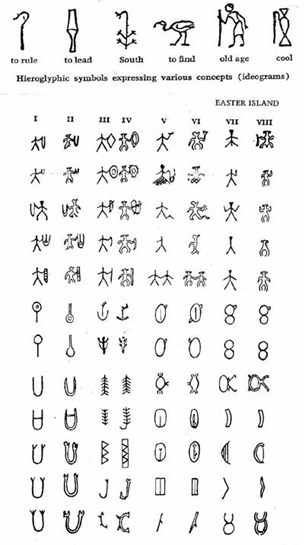 In the decades following the discovery of the Indus Valley Seals, researches noticed a correlation between the script on the Easter Island tablets and the Indus Script.
In the decades following the discovery of the Indus Valley Seals, researches noticed a correlation between the script on the Easter Island tablets and the Indus Script.
Here is a sample from the History of Writing illustrating the similarity between the Indus Script and the Easter Island (Rapa Nui) tablet writing called Rongorongo[i]. Column I, III, V and VII belong to the Indus Script.
Current scholars have downplayed the significance of these similarities for two reasons. First, the Indus Script was written 2000 or more years before the Easter Island tablets and secondly, Easter Island is on the opposite side of the globe from the Indus Valley separated in a large part by two oceans.
However, distance and time are not insurmountable barriers for human beings. Look at the Egyptians who maintained a writing system for thousands of years. The modern world tends to lord over the ancients the ability to travel the globe, while forgetting the significant sea trade routes maintained in the ancient Indian and Pacific Oceans.
Perhaps a closer look at the similarities between the Indus and Rapa Nui writing systems are a topic for scholars to consider.
Notice the following two Indus Seals with corresponding Rapa Nui Rongorongo glyphs. Not only do both writing systems use three circles stacked, but they also provide a variation of the glyph with a line through the center.
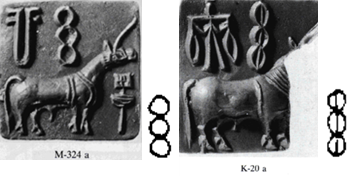
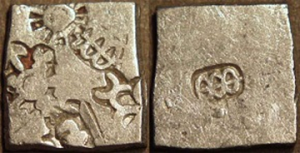 The second symbol is seen here on coins from the 3rd Century BC Ashoka dynasty of Northern India [iii]. The symbol represents Ashoka's mudra or royal mark, which represents the Caduceus or two snake and staff symbol of peace. Caduceus is a word originating from the Greek for herald’s staff. It was also called Aaron’s Rod and so became the universal sign for healing and medicine. Here on the Indus Seals and the Ashoka coin, it likely represents the sign to protect merchants and commerce. In this regard there is a link between Greco-Roman mythology and early India, where Hermes, in his aspect named Ningishzida, is the messenger of the Earth Mother.
The second symbol is seen here on coins from the 3rd Century BC Ashoka dynasty of Northern India [iii]. The symbol represents Ashoka's mudra or royal mark, which represents the Caduceus or two snake and staff symbol of peace. Caduceus is a word originating from the Greek for herald’s staff. It was also called Aaron’s Rod and so became the universal sign for healing and medicine. Here on the Indus Seals and the Ashoka coin, it likely represents the sign to protect merchants and commerce. In this regard there is a link between Greco-Roman mythology and early India, where Hermes, in his aspect named Ningishzida, is the messenger of the Earth Mother.
![]() Hermes received the Caduceus symbol, as a peace offering from Apollo in exchange for the tortoise shell lyre. The symbols reflect the ancient celestial constellation of Orion, shaped with the three stars in a row called, Orion’s belt.
Hermes received the Caduceus symbol, as a peace offering from Apollo in exchange for the tortoise shell lyre. The symbols reflect the ancient celestial constellation of Orion, shaped with the three stars in a row called, Orion’s belt.
Ashoka, then, a king devoted to peace, used the symbol for the double purpose of protecting commerce and negotiating peace. He was a king devoted to peace and he may have adopted the symbol from missionary activity of his Buddhist priests who travelled to the Mediterranean. Yet, his kingdom did include the Indus Valley region, which must have continued the traditional use of this symbol used on the Indus seals. The correlation suggests a remote ‘sharing’ of cultures by way of merchant and religious activity, much more plausible than the colonial Aryan invasion propaganda.
In the mythology, the offspring of Hermes, Asclepius (the healer), used the Caduceus to raise Hippolytus (un-leaser of horses) from the dead [iv]. This mythology intertwines with Hindu Mythology where the offspring of Sagara returns the stolen sacrificial horse from the Underworld and whose great-grandson, Bhagirathi, subsequently un-leased the Ganges upon the hair of Shiva, causing the 60 000 sons of Sagara to raise from the dead [v]. Interestingly, it is at the ancient Egyptian temple of Sakkara, where Orion is named Sahu. Sah/Sahu, in the constellation Orion, is the soul in the Sektet, boat of the setting Sun, which has been purified from earthly imperfections and can travel freely back and forth from sky to earth [vi]. Sahu is associated with the Sirius Constellation of the Cow following him in its own boat and the gate of the Great House where the souls of the City of the Sun bear offerings of bread, cake, sweet smelling flowers, and together with Sahu, the Great Cow [vii].
In Polynesia, Rigel of Orion is called, Poaka (the ball root), giving the three balls with the line through it as a sign of the genealogy of the founding fathers. Rapa Nui calls this genealogical belt of Orion the Beautiful Ones, referring to the founding father and two sons, perhaps a memory of Sagara and his offspring. The following 2nd Century CE Malayaman coin contains a possible variation of Ashoka’s Mundra with Indus and Rapa Nui Script comparasons. [viii-a]

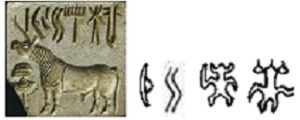 The Indus Seal contains as many as three glyphs remarkably similar to the Rapa Nui writing of Rongorongo. Notice the standing figure contains three upward strokes; the curved ‘river’ like glyph is identical with two lines and curve direction; and the ‘moon’ glyph contains a central swelling feature in both writing systems.
The Indus Seal contains as many as three glyphs remarkably similar to the Rapa Nui writing of Rongorongo. Notice the standing figure contains three upward strokes; the curved ‘river’ like glyph is identical with two lines and curve direction; and the ‘moon’ glyph contains a central swelling feature in both writing systems.
Remarkably, this moon feature appears to coincide in a near identical phrase of eight glyphs illustrated below:
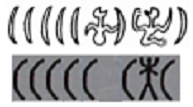 For these comparisons the Indus Script is in the lower grey and the Rapa Nui Script is given in the upper clear background.
For these comparisons the Indus Script is in the lower grey and the Rapa Nui Script is given in the upper clear background.
The Indus river, possibly represented in the center of the seal above is derived from the original name, Sindus, to flow, the ocean; sign of Varuna; water into which the soma drops. It is the name used while dropping the ‘s’ for the people of India.
Two more glyphs associated with the Sindus Ocean or River are illustrated below with Indus Seals on the left and Rapa Nui glyphs on the right:

The use of travel by merchant vessel enabled these seals to accompany their shipments near and far. For instance the following Indus seals were found in excavation of Ur, Mesopotamia (the first 4) and Southeast Asia (bottom) [viii].
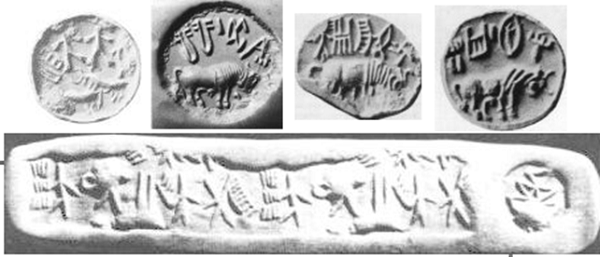
Another Indus seal found in Mesopotamian is shown here [ix]:
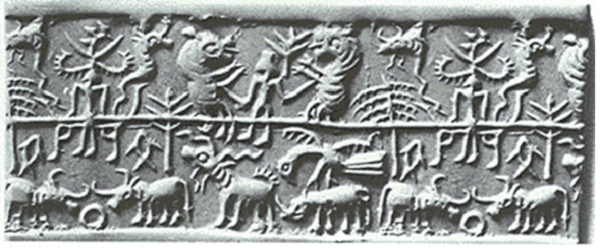
The point of such seals is to be used by merchants to transfer commercial goods. Finding them far beyond the Indus valley is no surprise. It confirms an open trade route existed there and should lead to a greater understanding of some shared symbolism and mythology as well.
These symbols appear on early India’s post Mauryan kingdom coins:
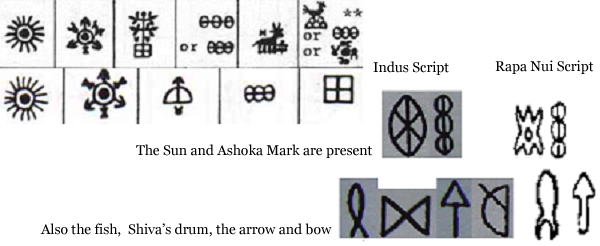
What appears to be a fish, actually occurs on ancient Indo-scythian, Indo-parthian and Kushan coins in several forms listed here [x]:
![]()
These emblems vary in name from the Nandipada on the left, the central malhar or ma symbols, and even the Mediterranean standard on the far right. Their appearance may help further understand the variations of vessel glyphs on the Indus seals.
Shiva’s drum is shaped like an hour-glass as on this early Dancing Shiva statuette and ancient Indian coin.
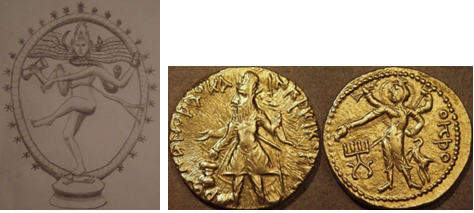
The coin is a gold dinar from the 2nd Century CE Kushan kingdom. The crowned king is holding a spear and small sacrificial altar. The Bactrian legend reads: þAONANOþAO KA NηþKI KOþANO, King of Kings Kanishka Kushan. The reverse side presents a tamga royal emblem on the left and an early four-armed Oesho (Shiva) holding a trident, water pot, deerskin, and damaru drum synonymous in sound and appearance with the thunderbolt symbol. The Bactrian legend right reads: OnþO or Oesho/Wesho, the Iranian Wind God.
Shiva as the Wind God makes sense in terms of the water vessel and ‘lightning’ drum he holds. The water of the Ganges falls upon his head, as in the above statue. The power of this wind, fire and water can destroy, which illustrates Shiva’s title as destroyer. But these elements also bring new life, which symbolize the creative aspect of the god. Perhaps the hourglass also represents a butterfly in this dying and restoring sense. Butterfly, drum or lightning bolt, the Shiva drum expands the potential meaning of the variations of hourglass Indus glyphs.
The Nandipada symbol (possibly representing the AUM) also appears on the Indus seals in various forms:
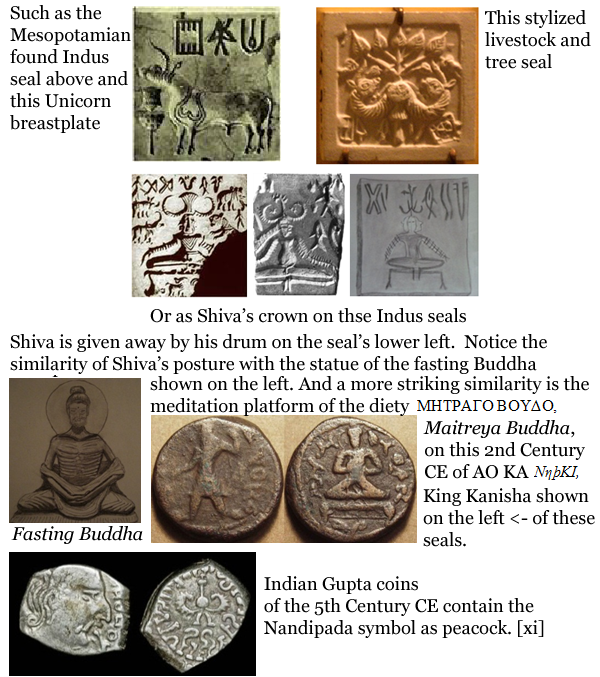
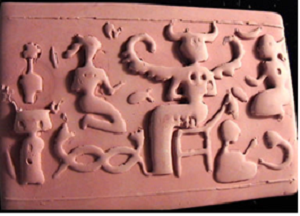 Notice the peacock wings and their similarity to those of Ishtar from this reproduction of a 20th Century BC Sumerian seal [xii]. It shows the goddess Ishtar with crescent horns. The curled-feathered wings resemble the Indus valley symbol of the Nandipada. Ishtar was goddess of fertility, love and war. Her wings enable her to reign over the sky. Having the head of a bull she unleashes the Bull of Heaven on earth. Around her are fish reflecting the flood Epic of Gilgamesh. Present on the seal is the earth god Ea-enki, akin to Enkidu, friend of Gilgamesh who helps him to sacrifice the heavenly bull of Ishtar to the deity of the sun, Shamash. On the seal, Ea-enki is holding a branch after the flood representing the Tree of Life. The star on his head represents the separation of earth and sky, and power over the sky of Ishtar and the snakes intertwined at his feet. The pillar with star and snakes are reflective of Ashoka’s mundra on the Indus seals. On the seal are Ishtar’s attendants appearing much like those honoring Shiva on the Indus seals. Ishtar also has a snake charmer. In the mythology, Ishtar jumps upon the high wall of Uruk, the city of king Gilgamesh. She curses Gilgamesh, but is struck in the face by the leg of the bull thrown by Enkidu.
Notice the peacock wings and their similarity to those of Ishtar from this reproduction of a 20th Century BC Sumerian seal [xii]. It shows the goddess Ishtar with crescent horns. The curled-feathered wings resemble the Indus valley symbol of the Nandipada. Ishtar was goddess of fertility, love and war. Her wings enable her to reign over the sky. Having the head of a bull she unleashes the Bull of Heaven on earth. Around her are fish reflecting the flood Epic of Gilgamesh. Present on the seal is the earth god Ea-enki, akin to Enkidu, friend of Gilgamesh who helps him to sacrifice the heavenly bull of Ishtar to the deity of the sun, Shamash. On the seal, Ea-enki is holding a branch after the flood representing the Tree of Life. The star on his head represents the separation of earth and sky, and power over the sky of Ishtar and the snakes intertwined at his feet. The pillar with star and snakes are reflective of Ashoka’s mundra on the Indus seals. On the seal are Ishtar’s attendants appearing much like those honoring Shiva on the Indus seals. Ishtar also has a snake charmer. In the mythology, Ishtar jumps upon the high wall of Uruk, the city of king Gilgamesh. She curses Gilgamesh, but is struck in the face by the leg of the bull thrown by Enkidu.
 A memory of such an offering portion may be reflected in this Indus Valley sign. This will cost Enkidu his life. Ishtar demands the bull from the underworld in order to cause the dead to devour the living. A dance is held by Ishtar over her court to mourn the bull of heaven. Perhaps the mythology intertwines with the dancing Shiva and the offering horse of Sagara. As well, mystery of the one-horned ox high upon a wall may be unraveling in the defeat of Ishtar with the offering of Enkidu thrown upon the wall of the city. Shamash is pleased with the sacrifice of Gilgamesh and Enkidu resulting in enlightenment and justice restored to humanity and the poor being released from the serpent demons of Ishtar [xiii]. The theme of sacred offerings after the great flood of Gilgamesh plays into the Indus civilization symbolism, which coincidentally was washed away by a flood.
A memory of such an offering portion may be reflected in this Indus Valley sign. This will cost Enkidu his life. Ishtar demands the bull from the underworld in order to cause the dead to devour the living. A dance is held by Ishtar over her court to mourn the bull of heaven. Perhaps the mythology intertwines with the dancing Shiva and the offering horse of Sagara. As well, mystery of the one-horned ox high upon a wall may be unraveling in the defeat of Ishtar with the offering of Enkidu thrown upon the wall of the city. Shamash is pleased with the sacrifice of Gilgamesh and Enkidu resulting in enlightenment and justice restored to humanity and the poor being released from the serpent demons of Ishtar [xiii]. The theme of sacred offerings after the great flood of Gilgamesh plays into the Indus civilization symbolism, which coincidentally was washed away by a flood.
These peacock/goddess wings and livestock Nandipada have a remarkable resemblance to the following Rapa Nui glyph:
 or inverted
or inverted  here to highlight its likeness to the coins and seals.
here to highlight its likeness to the coins and seals.
Also, worthy of notice is the similarity between these Gupta coins’ peacock tail-feathers, the illustration of the Rapa Nui man’s forehead tattoo and this Sumerian seal [xiv]:

The bird for a headdress is a symbol used on this Kushan 2nd Century AD gold dinar:
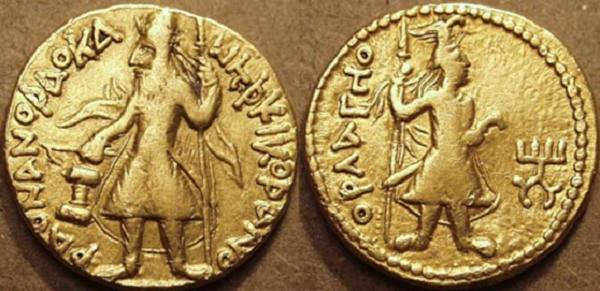
The king has a spear and offering vessel. On the reverse the legend reads Orlagno who is Verethraghna, the personification of victory. The head-dress bird is Varagna, possessor of special powers or raja.
Also, the post Mauryan coin symbols illustrated above contain these animal glyphs  similar to the Indus seal glyphs
similar to the Indus seal glyphs  and the above Kushan gold dinar with deerskin:
and the above Kushan gold dinar with deerskin:  ..
..
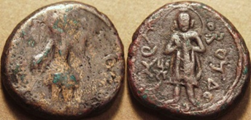 Another 2nd Century CE Kushan coin shown here: has a reverse legend reading, CAKAMAN O BOYΔO, Sakyamuni Buddha, who holds a robe with reading: abhayamudra, "have no fear".
Another 2nd Century CE Kushan coin shown here: has a reverse legend reading, CAKAMAN O BOYΔO, Sakyamuni Buddha, who holds a robe with reading: abhayamudra, "have no fear".
In Rapa Nui, there is a robe of feathers worn by the island lords or chiefs, called atua (meaning lord), shown in this pair of Rapa Nui glyphs for the moon days atua and hotu: 
Notice the resemblance here to the wing of the peacock from the above Gupta coin:  .
.
The Rapa Nui hotu glyph can be paired with the identical Indus seal glyph for the swelling crescent moon: ![]() .
.
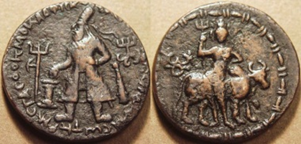 Another 2nd Century CE Kushan coin shown here: contains both the king and the deity Shiva having tridents, which may also represent lightning in this eras mythology. The tamgha royal emblem is present on the right.
Another 2nd Century CE Kushan coin shown here: contains both the king and the deity Shiva having tridents, which may also represent lightning in this eras mythology. The tamgha royal emblem is present on the right.
Tamghas appear in the following varieties: ![]() , much like a trident or the Indus seal glyph
, much like a trident or the Indus seal glyph ![]() Pal likens to a tree. This Indus Script tree glyph also doubles as seen to the right below in grey, similar to the third symbol of five from a Sri Lanka, Ajatasatuu dynasty coin [xv]:
Pal likens to a tree. This Indus Script tree glyph also doubles as seen to the right below in grey, similar to the third symbol of five from a Sri Lanka, Ajatasatuu dynasty coin [xv]:

The following coins contain the tamgha tree used as a rail for the Hindu-swastika found on many Indian coins and merchant seals [xvi]:

Other symbols include the elephant with Bodhi tree, a three-arched hill (caitiya) and on the reverse a throne, and a nandipada (early Aum symbol as in the peacock wings) with three-arched hill in lower center [xvii].
Other symbols include the royal standard (Dhajaya) on either side with the steps of a temple upon a boat.
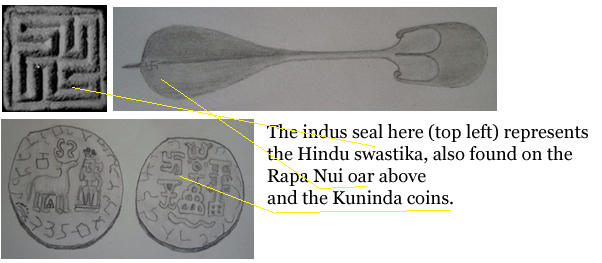
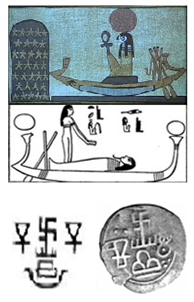 The boat on the Sri Lanka coin reflects the Egyptian book of the dead seen below [xviii], where the Egyptian aank symbol of life, seen here on the knee of the Osiris (hawk-headed) deity, resembles the Indian royal standard and the throne. Notice the lower Egyptian throne symbol confirms the interchangeability of the throne with the standard on the Indian coins. Therefore, the boat of the underworld contains a throne or a standard which represents the perpetual life of the nation.
The boat on the Sri Lanka coin reflects the Egyptian book of the dead seen below [xviii], where the Egyptian aank symbol of life, seen here on the knee of the Osiris (hawk-headed) deity, resembles the Indian royal standard and the throne. Notice the lower Egyptian throne symbol confirms the interchangeability of the throne with the standard on the Indian coins. Therefore, the boat of the underworld contains a throne or a standard which represents the perpetual life of the nation.
See how the Egyptian compares to the coins of India: Notice also the boat and the three-arched hill are intended synonyms on the coins just as the aank is synonymous with the standard and the throne as symbols of life. This boat-hill correlation confirms the intended symbolism of the ship of the dead represented in the Sun’s journey through the sky of the underworld in the constellations to rise again at dawn. This hill is actually represented as dawn in the Egyptian akhet symbol below [xix]:
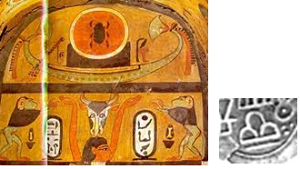 The akhet contains the sun at dawn rising between two hills. On this fresco, a scarab beetle, a sign of rebirth, is present in the rising sun. All are contained inside the boat of the dead. Therefore, the Hindu three-arched hill may be synonymous with the dawn of the Egyptian akhet. The Babylonians also considered the Sun god as central between to hills [xx].
The akhet contains the sun at dawn rising between two hills. On this fresco, a scarab beetle, a sign of rebirth, is present in the rising sun. All are contained inside the boat of the dead. Therefore, the Hindu three-arched hill may be synonymous with the dawn of the Egyptian akhet. The Babylonians also considered the Sun god as central between to hills [xx].
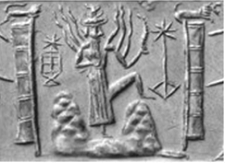 From these common mythological themes common symbols can be found, such as the bent arched pillars surrounding the sun deity. Such a bend-pillar surround is explored at the end of this research below. Whatever culture we find the use of these constellations and sky symbols more can be learned of the story of the passage of the dead to life beyond the grave.
From these common mythological themes common symbols can be found, such as the bent arched pillars surrounding the sun deity. Such a bend-pillar surround is explored at the end of this research below. Whatever culture we find the use of these constellations and sky symbols more can be learned of the story of the passage of the dead to life beyond the grave.
The post Mauryan coins with symbols listed above contain representations of the tree and the fence below the tree as follows:

Notice how these Sri Lanka coins contain variations of the Bodhi tree railing just as the Indus Script in the grey below [xxi]:

In ancient India, the tree is represented by the offering post that livestock would be tied to as part of the sacrificial ceremony of the animal. Such offering posts, seen here: ![]() , on the reverse of Nandipada coins confirm similar representation on the Indus and Rapa Nui scripts - These Indus symbols occur in the following forms:
, on the reverse of Nandipada coins confirm similar representation on the Indus and Rapa Nui scripts - These Indus symbols occur in the following forms:
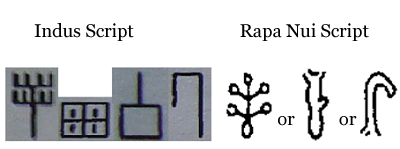
Notice these ancient India Chandra Gupta coins with sacrificial horse.
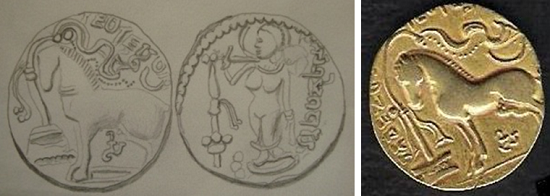
The horse is tied to the sacrificial post resembling the box and arches of the Indus seals shown here:  and the arch of the Rapa Nui tablets:
and the arch of the Rapa Nui tablets: ![]()
Maha raja or Great King are often named on these seals and coins.
The script on the Indus seals have similar patterns that may represent Maha raja or like adjectives together with the variations that represent separate names of the officials of the city the seal was located.
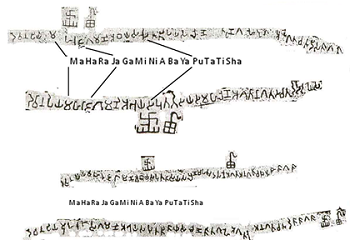
On the above Sri Lanka engraving these raja or emblems also include the boxed in staff, which confirms that the offering post with arched top is also present with a box at the base. Therefore, there is a possible relationship between the two Indus seal glyphs shown here: 
The following Indus seal is mimicked with Rapa Nui glyphs: 
NNotice the arched poles tattooed on the torso of this Rapa Nui woman:
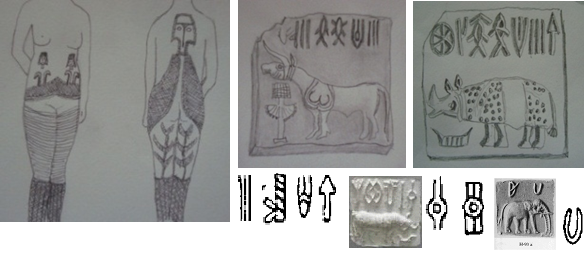
Various common glyphs and glyph elements: three bars; a lower left appendage; a three line vessel; an arrow. A line with a central circle a ‘U’ shape. Pictures of vessels appear to have two and three upper extensions in common.

Research by Rajot Pal has determined this vessel sign as the syllable ‘ka’ [xxii]. The Indus seals place these vessels at the end of glyph sequences. Pal’s full seal interpretations has found these to be personal names, where ‘ka’, meaning ‘who is’, is placed as the common suffix for Indian names. Pal’s use of the Brahmi parallels and acrology presents a verifiable interpretation of the Indus Script.
 For instance, the Egyptian ‘ka’ sign for the soul appears similar to the Indus Script vessel
For instance, the Egyptian ‘ka’ sign for the soul appears similar to the Indus Script vessel  Pal also interprets as ‘ka’. Pal’s use of the ‘ka’ as ‘who is’ reflects the same meaning of the Egyptian ‘ka’ as the soul. Furthermore, the Egyptian ‘ka’ means the souls perfected double with arms raised in a gesture to make the perfect offering. Such offerings are illustrated with animal pictoglyphs on ancient Indian coins and seals.
Pal also interprets as ‘ka’. Pal’s use of the ‘ka’ as ‘who is’ reflects the same meaning of the Egyptian ‘ka’ as the soul. Furthermore, the Egyptian ‘ka’ means the souls perfected double with arms raised in a gesture to make the perfect offering. Such offerings are illustrated with animal pictoglyphs on ancient Indian coins and seals.
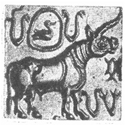 Elaboration of Pal’s ‘ka’ syllable is found on this Indus seal surrounding the circled goose: Notice in the Upanishads a description of this wheel and goose is given:
Elaboration of Pal’s ‘ka’ syllable is found on this Indus seal surrounding the circled goose: Notice in the Upanishads a description of this wheel and goose is given:
Svetasvatara Upanishad Book I, verse 6:
“In this mighty wheel of brahman,
life-giver to all, rest to all,
Roves a goose.”
The goose represents the self as confirmed by Pal’s ‘ka’ surround, “Who is the true Brahman Hansa (full of grace as the goose) self who is.”
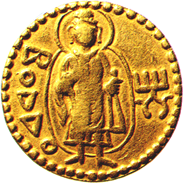 This Indus seals use of the Bhudda wheel as a pictoglyph surround is confirmed on the Kanishka/Milinda era coin with rings around the Buddha’s head and body [xxiii]:
This Indus seals use of the Bhudda wheel as a pictoglyph surround is confirmed on the Kanishka/Milinda era coin with rings around the Buddha’s head and body [xxiii]:
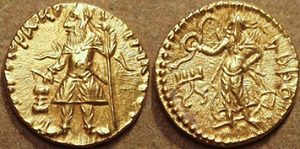 Pal’s use of acrology to determine the syllables of the Indus Script is demonstrated on the following 2nd Century CE Kushan gold dinar:
Pal’s use of acrology to determine the syllables of the Indus Script is demonstrated on the following 2nd Century CE Kushan gold dinar:
On the reverse, notice the deity holding left the diadem with the right Bactrian legend reading: ATþO, Athsho, god of metals. The shape of the diadem is the shape of the Greek letter ‘þ’ in the deity’s name. This is acrology at its finest.
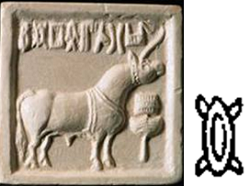 On the following Indus seal and Rapa Nui glyph the wheel contains four ‘sun’ like rays in both writing systems:
On the following Indus seal and Rapa Nui glyph the wheel contains four ‘sun’ like rays in both writing systems:
How does the Brahman Wheel enhance our understanding of the glyphs with circles below containing various appendages within on both the Indus seals and Rapa Nui tablets:
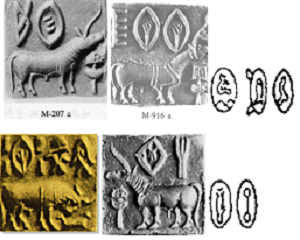
Coins of ancient India’s Vidarbha region contain symbols with figures inside a circle: 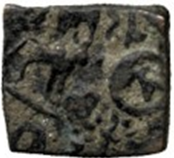 much like this Indus glyph
much like this Indus glyph ![]() . Another copper from Vidarbha 300 BC reveals the three-arched hill with crescent moon atop and circled opposite the circled hollow cross:
. Another copper from Vidarbha 300 BC reveals the three-arched hill with crescent moon atop and circled opposite the circled hollow cross: 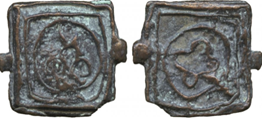 Are these three hills and moon not also represented on the Rapa Nui fullmoon glyph
Are these three hills and moon not also represented on the Rapa Nui fullmoon glyph![]() ?
?
Remarkably, the fourth image stamped onto a coin of Sri Lanka’s Ajatasattu dynasty contains the four mark surround common to the Indus Script as seen in the grey ‘hand-in-circle’ glyph below [xxiv]:

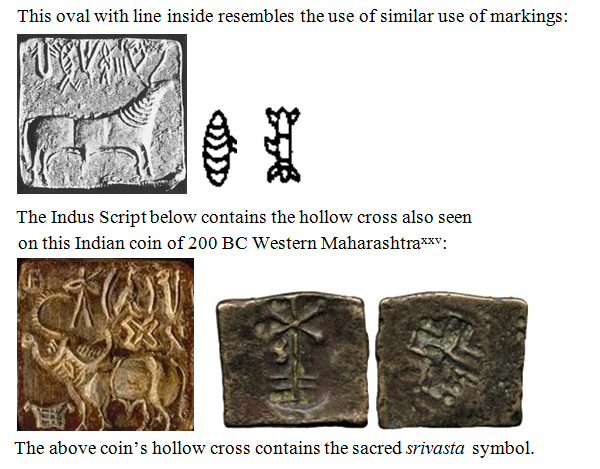
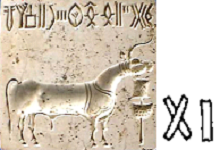 The above seal contains the hollow ‘x’ with a hollow bar similar to the Rapa Nui tablets. Below is an attempt to use individual Indus seal glyphs (in grey) to match the Rapa Nui tablet phrases. The purpose of this matching is to illustrate enough common elements between the scripts to share not only individual letters and words, but potential common phrases as well.
The above seal contains the hollow ‘x’ with a hollow bar similar to the Rapa Nui tablets. Below is an attempt to use individual Indus seal glyphs (in grey) to match the Rapa Nui tablet phrases. The purpose of this matching is to illustrate enough common elements between the scripts to share not only individual letters and words, but potential common phrases as well.

The Indus seal ‘ladder’ glyph does not appear exactly as the Rongorongo ladder, however, consider the glyphs on this ancient bench in Hambantota, Sri Lanka [xxvi] and compare the ‘framed’ ladder with the Rapa Nui glyph below:
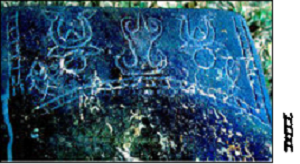
The triangle appears on the nandipada symbol circled below as well as the Indus seal and Rapa Nui glyph occurring twice below:
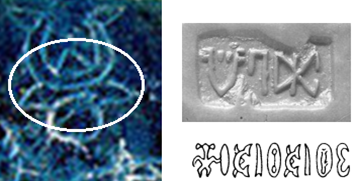
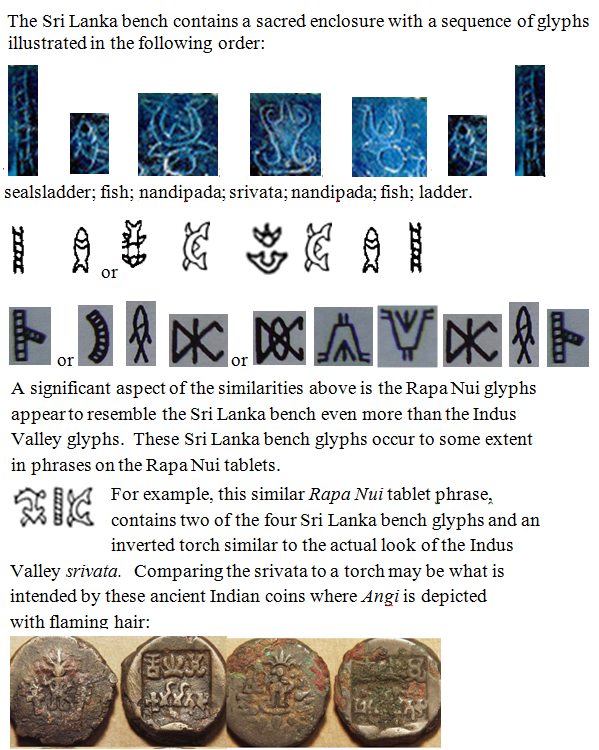
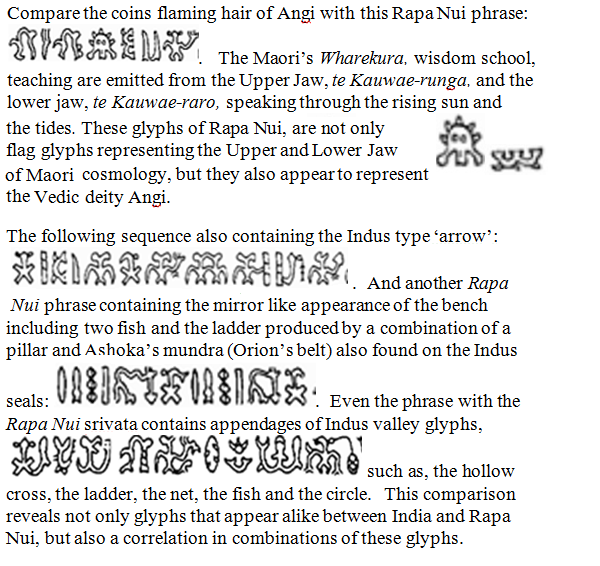
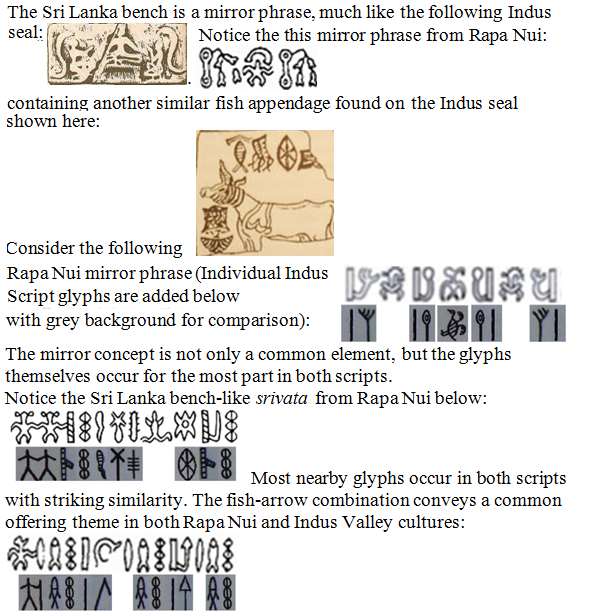
There are several Indus seals and Rapa Nui phrases that contain fish - arrow combinations with several other common elements. Examples are given below:

This arrow-fish phrase on the Rapa Nui tablets is approximately reproducible with the Indus Script:
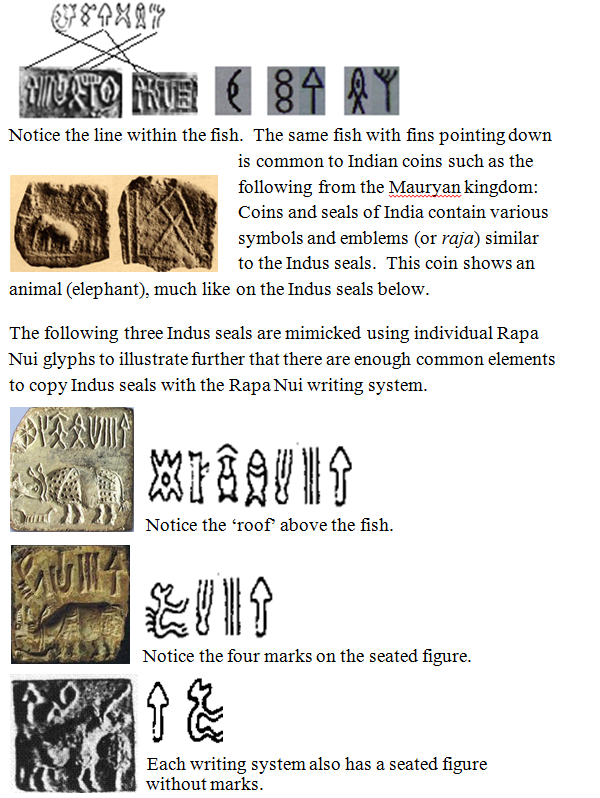
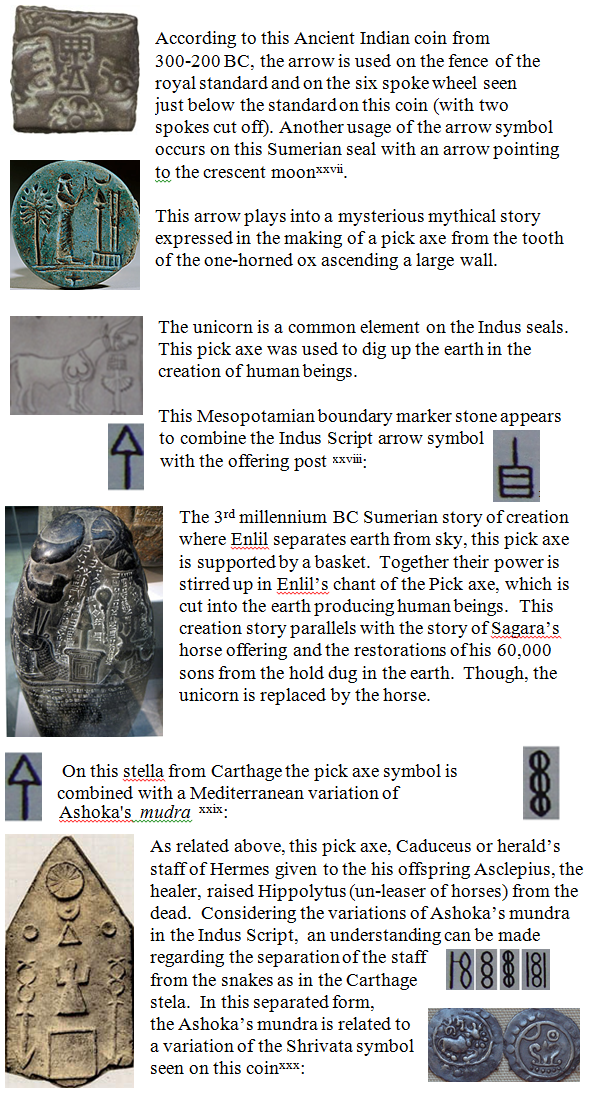
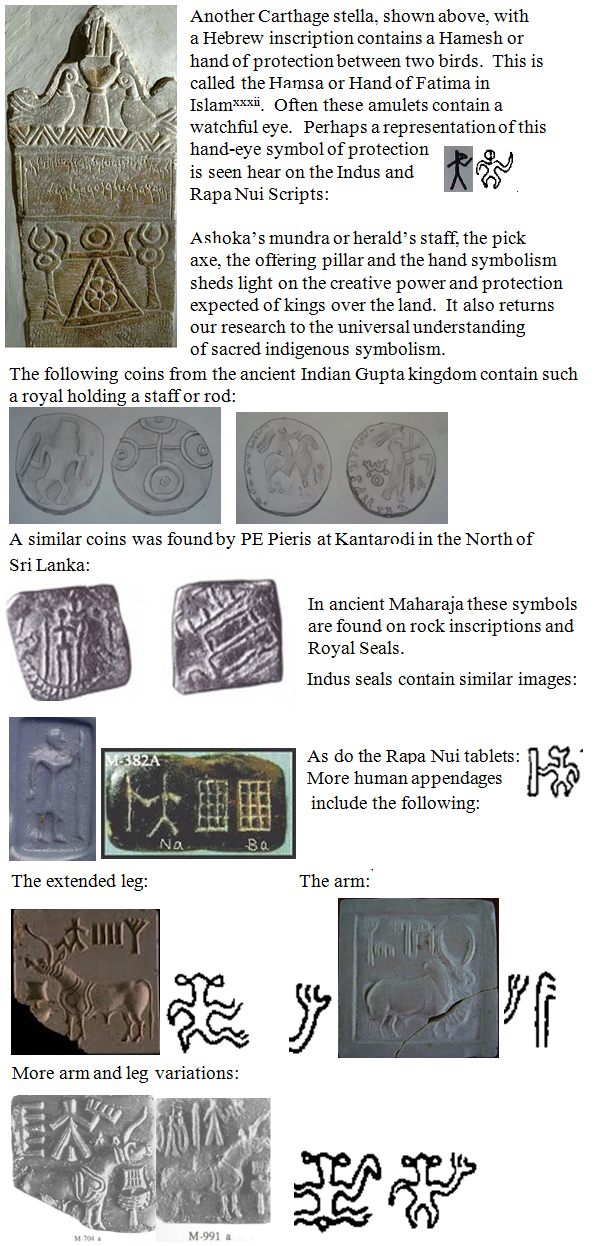
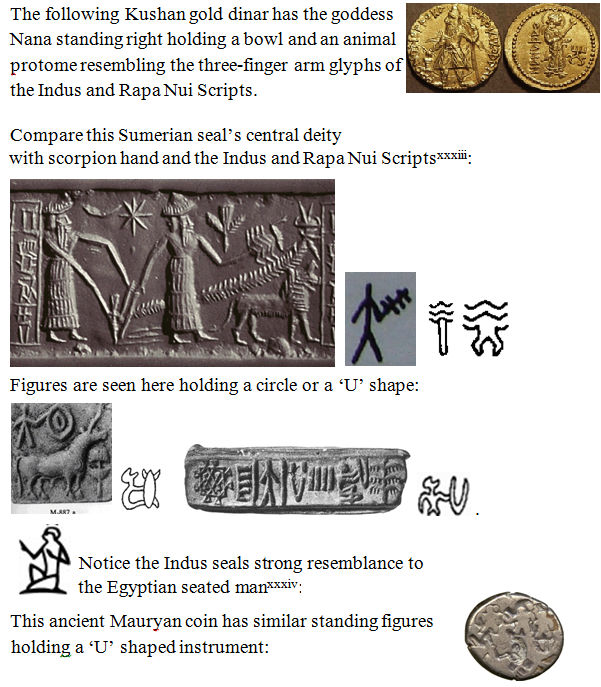
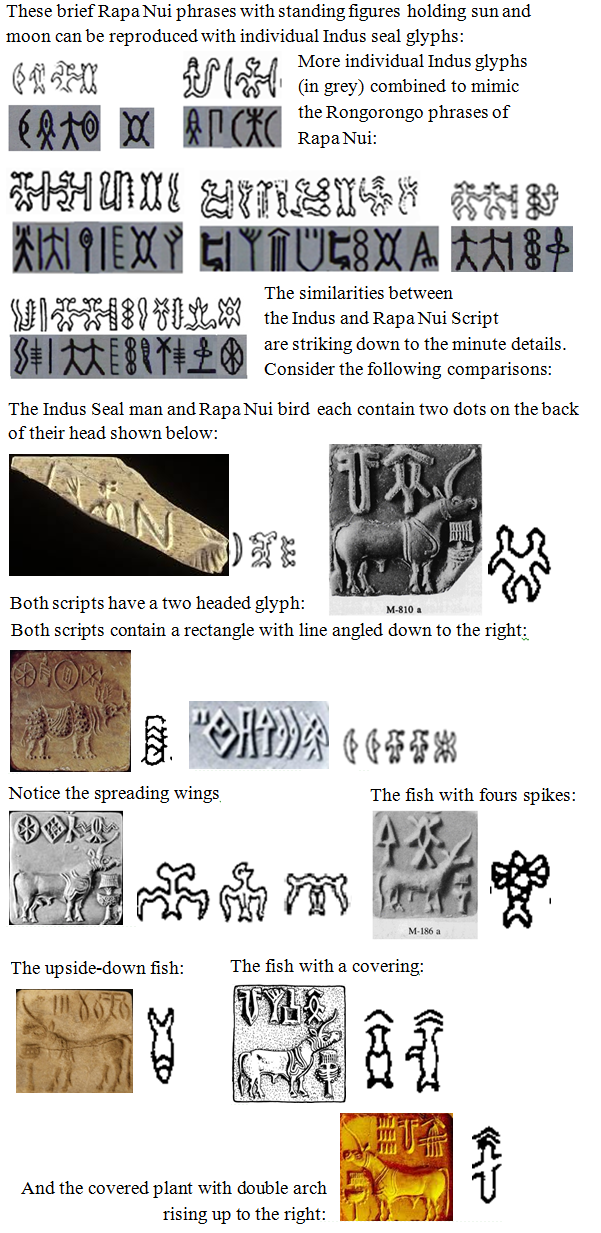
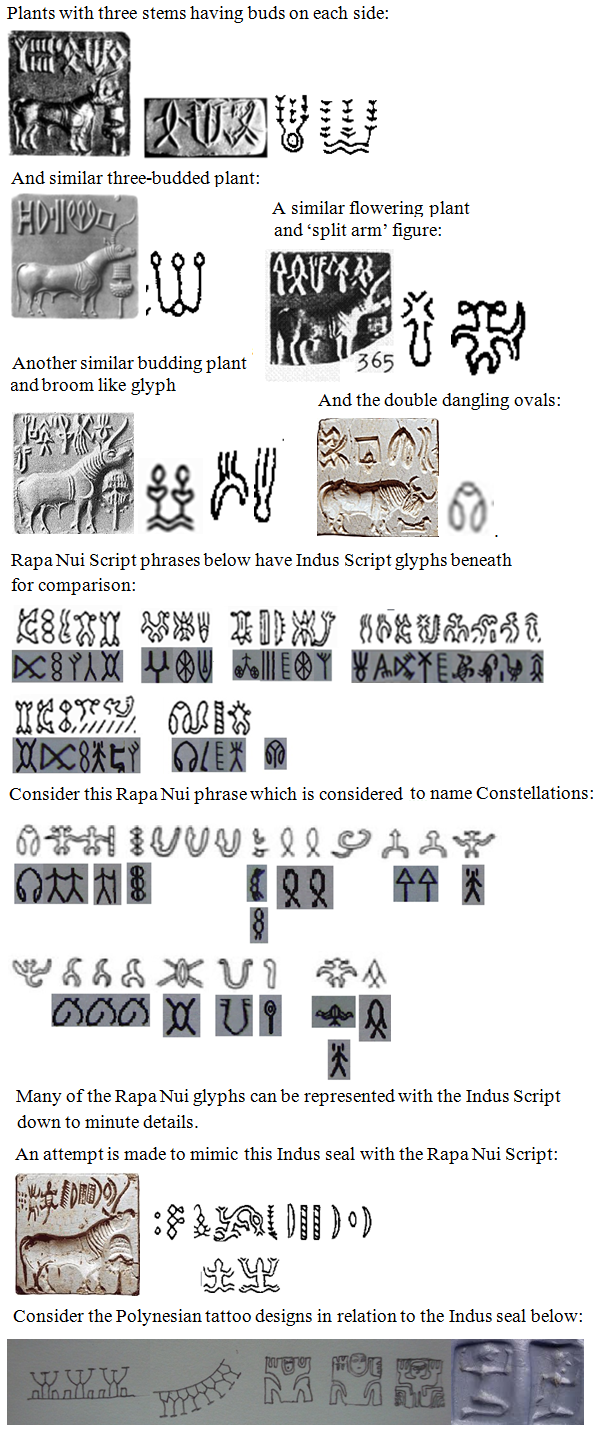
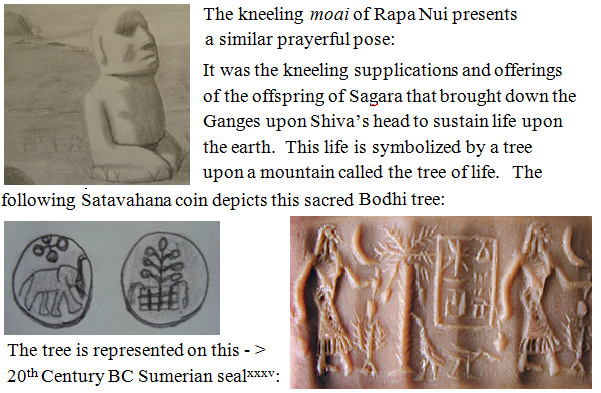
The goddess Inanna is picking the fruit of the sacred palm tree appearing to reproduce a young sprout. The imagery reflects the story of Eve in Eden, with the picking of the sacred fruit which brought on the toil of agriculture. Inanna is accompanied by her sacred birds. The purpose of the offering of the first fruit is to express gratitude to the Creator for its reproductive quality. This concept of sacrifice extends to the four corners of the earth.
The Ujjain symbol representing these four earth corners appears on early Indian coins of the regions Ujjain, Eran, Vidarbha, Satavahana and others. The symbol appears as four balls with a central cross connecting them. Another early Indian Satavahanas coin is compared to the Indus and Rapa Nui Script glyphs of the Ujjain symbol below:
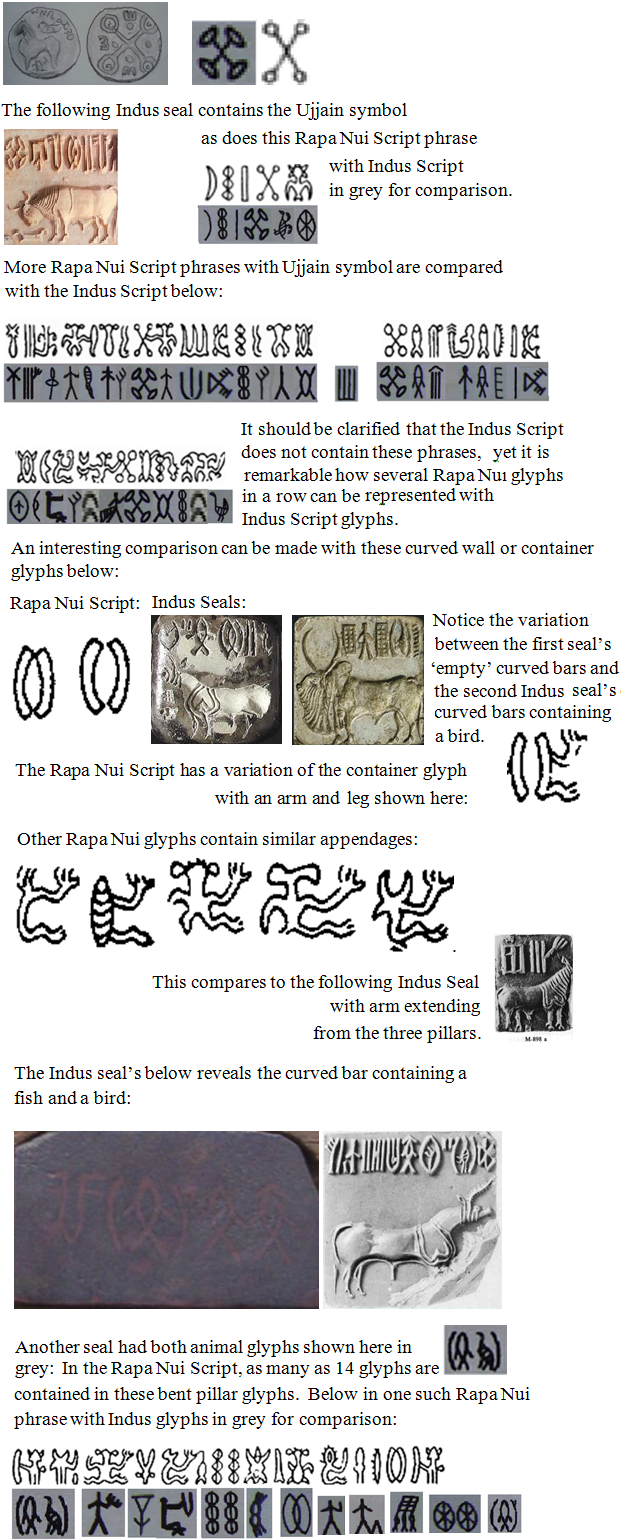
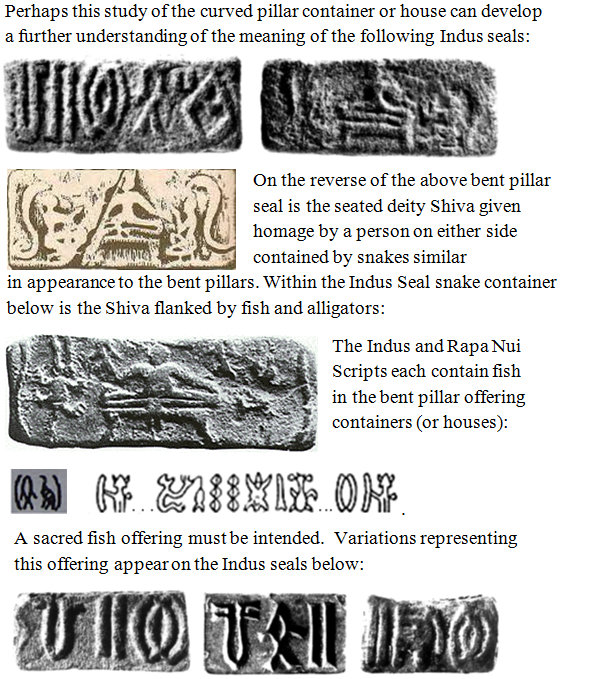
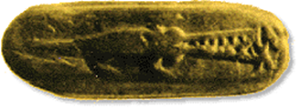 The alligator itself is given the fish offering in the following Indus seal. The Egyptian Alligator is the deity of the Nile, which was of central importance to the Egyptians. Here the Alligator must represent the Indus River and be of significant importance to the Indus Valley culture. Yet, Shiva is offered the fish and alligators in the seal above, presenting a hierarchy of deities similar to the pantheon of neighboring cultures. For example, the Egyptian hawk-headed Horis spears the Alligator Set of the Nile in the Egyptian Book of the Dead [xxxvi] and Legends of the Gods [xxxvii]:
The alligator itself is given the fish offering in the following Indus seal. The Egyptian Alligator is the deity of the Nile, which was of central importance to the Egyptians. Here the Alligator must represent the Indus River and be of significant importance to the Indus Valley culture. Yet, Shiva is offered the fish and alligators in the seal above, presenting a hierarchy of deities similar to the pantheon of neighboring cultures. For example, the Egyptian hawk-headed Horis spears the Alligator Set of the Nile in the Egyptian Book of the Dead [xxxvi] and Legends of the Gods [xxxvii]:
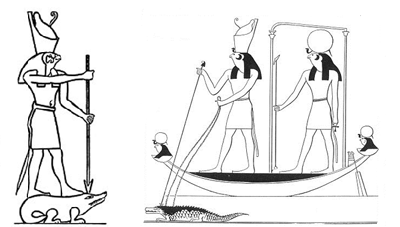 It is Horis and Isis who kill the Alligator, Set, who tore Osiris to pieces. They then restore Osiris to life. Isis uses her powerful incantations and is protected by seven scorpions.
It is Horis and Isis who kill the Alligator, Set, who tore Osiris to pieces. They then restore Osiris to life. Isis uses her powerful incantations and is protected by seven scorpions.
Another example occurs in the following Sumerian seal which contains a journey on the boat of the underworld with two crowned persons (deities) and one person (deity) with a lion’s body together with the offering for the dead [xxxviii].
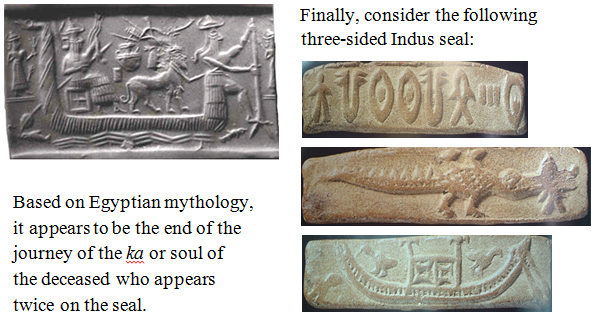
First, he appears at the beginning of the Indus Script’s mirror phrase with Pal’s ka vessels and sun glyphs. Secondly, the man appears on the outside of the underworld boat, which is an indication he is at the end of his journey. In the central portion of the seal, the alligator is offered the fish from the initial phrase. This seal combines with the Shiva offering seals above to mimic the Rapa Nui bent pillar phrase.

The common lines run from left to right on the Rapa Nui phrase as follows:
Bent pillar (snake) offering surround
Water Monster (Alligator)
Seated deity with raised arm
Vessel (or open mouth)
Captured fish offering
The success of the deceased (in fishing / in completing journey)
Three (Orion’s belt, symbolic of the abode of the ancestors and succession of lineage)
Double Sun
Seated enlightened human paying homage
Boat
Bent pillar house (container)
House on (next to) boat
Double-bar pathway (for the underworld boat)
The story of rediscovering the lost Indus Valley and Rapa Nui writing systems lead to a significant correlation of symbolism across India and surrounding cultures. This transmitting of symbolism occurred over many centuries. The Indus valley merchants and priests shared a unifying effect across the cultures by transmitting their cultural symbolism and mythology. The symbols represented on Indus Valley merchant seal are integrally connected to the spiritual, mystical and mythical ways of the Indigenous people. Given they are seals used in trade and commerce abroad, a universality of symbolism has developed and assisted greatly in carrying out the research.
Egypt and Mesopotamia were explored in this research and several mythical elements that cross the cultures towards the Indus civilization were found. Some of the Indus Script glyphs were defined using this method and many more signs were better understood. To say that these signs used by the merchants and priests of the Indus Valley have universal appeal is an understatement when researching how they relate to the Rapa Nui Script used on the other side of the globe 2500 to 3500 years later. It is unnecessary to argue that the 1000 year old bark containing the Indus Script warrants a comparative analysis into the Indus Valley and Rapa Nui script. The symbolism has proven itself to span the test of time and geography by its presence confirmed to cross much of the world and much of human history in the above research.
This research warrants an in depth study regarding the migration of Indus Valley peoples after the flooding of the Indus Valley 3500 years ago. The research confirms that this migration spread to Polynesia and its writing script moved with the migration that lasted 1500 years until it reached the shores of Rapa Nui. The writing system changed as to be expected, but it is proven above to have a common origin. This research also confirms the ‘ka’ vessel syllable of the Indus Script found by Rajot Pal [xxxix]. The method of his research in use of comparative Brahmi has been proven effective in the initial stages of deciphering the Indus Valley Script. The above research relies heavily on his method of acrology or comparison with known symbols and their definitions.
References & Images Source:
27-Oct-2012
More by : Anonymousfor JoshuaMessiah

|
J. Innes Miller [11] believes that a “study of the Sanskrit ele- ment in Malagasy as compared with that in Malay is important as an indicator of when the colonization of Madagascar occurred”. He argues that the Sanskrit terms used in Malagasy refer to “common objects affecting everyday life” and that these “were probably brought in by Kalingan traders long before hinduization by settle- ment began”. |

|
Ashoka has nothing to do with Polynesia. Sometimes the historians have exaggerated about Ashoka. Kalingan were great navigators at the time of Harappa, Indus Valley. Kalinga boats had reached the coasts of Africa, and Americas. When Christopher Columbus arrived near to Puerto Rico island, he first met the caribe people, they call themselves "Kalinga/Kalingo". Their consonants and vowels exactly similar to "Kalinga/Odia/Sanskrit". Hindu names among the Arawak and the Guaymi. |

|
Have you received my comments sent by me today 10 minutes before,? pl confirm Statues at Ester Island were made by Sagar 's sons who travel to South America ,Sapta Patal from India but landed at Ester Island due to their ship Wreck . |

|
Samrat Bhaghirath is Grand Nephew of Samrat Sagar सगर He brought River Ganga from Himalya by diverting its path. River Ganga was brought from Himalya to purify Sagar's 1000 Sons Soul.Samrat Sagar performed Ashwamedh Yadnya and his Horse was stolen by Daitya and was Taken to Sapta Patala. .His 1000sons went for searching the same from India by Ship due to the ship wreck they landed at today's Ester Island and made these statues.Samrat Bali was pushed to today's South America Sapta patala |

|
Polynesian are more connected to ancient navigators of Klinge or Kalinga. Rapa Nui script is part of ancient Kalinga script. |

|
The research article is undoutedly significant contribution towards better understanding of the puzzlesome Indus velley script, synmbolism on punch mark coins and rapa nui glypics. I have vast collection of ancient punchmark coins as well as cast coins of indian antiquity. The volume of collection during the period 1980 to 2005 is so lar.ge that it raises the question of period of circulation of punch mark coins. The numismatician who subscribe a period of 4oo b.c. to 2oo a.d. seems quite inadequate for the large volume to survive. There seems to be a continity of circulation over a period of more than 1500 years to justify the vast area and huge volume of punch mark coins to have survived to date. Some symobls on the puch mark coins have global similarity but a large number of symbols are still waiting for interpretations so as to generate the similarity to an ancient script. Thanks for contribution |

|
There is an ancient Maori tribe in New Zealand (Ngati Hotu)who have conections to Easter Island and who state that there people came out of Persia at the time of a great war with dark skinned peoples . These people settled by way of the america's (mexico and peru ) in Easter island where they became mixed with Polynesian people .This is a very small tribe and is not accepted bu the main Maori tribes who dismiss them , yet there is much evidence that is over looked or just ignored to suit there histories . |

|
Could it be that the original inhabitants of Easter Island were sailors and their wives from a shipwreck that originated in the area of India and this is their story. In ancient times some countries allowed women on board and did not consider them as bad luck. Or it could be that they could have also been outcast and set adrift ending up on the island. Just some food for thought. |

|
Please visit Facebook pages 'Indus Script Dictionary' and Rongorongo FB for more photos and alternate theories as to what is encoded in Indus Script and Rongorongo. |

|
please find all my six papers The Demise of the Dravidian, Vedic and Paramunda Indus myths I am publishing my sixth research paper directly online as it is an extension of my previous papers. Kindly read pages 4 to 18 as it contains a detailed discussion of the term ‘Aryan’. This paper shows why the Dravidian, Vedic and Paramunda Indus theories are not tenable. http://www.scribd.com/doc/136268397/The-demise-of-the-Dravidian-Vedic-and-Paramunda-Indus-myths Methods to reconstruct the languages of the Harappans were presented in the present and previous papers. We hope other scholars take up the exercise of reconstructing the languages of the Indus Valley civilization! The older papers were written taking the assumptions of the 19th century school of Indology as a base and working backwards. These may appear to be outdated now (at the end of our very long journey). However, the fundamentals are still correct. Part one http://www.scribd.com/doc/27103044/Sujay-NPAP-Part-One Part Two very,very important! http://www.scribd.com/doc/27105677/Sujay-Npap-Part-Two (These comprise the complete and comprehensive solution to the Aryan problem) for those who have trouble reading part two in the above link use the link below: part one http://www.docstoc.com/docs/25880426/Sujay-NPAP-Part-One part two (very important) http://www.docstoc.com/docs/25865304/SUJAY-NPAP-Part-Two Literacy in pre-Buddhist India (before 600 BC) Literacy in pre-Buddhist India (before 600 BC) Please find my collection of papers on literacy in Pre-Buddhist India Before mature phase of Indus valley civilization (before 2600 BC) - There are some potters marks but none qualify as full writing Indus valley civilization (2600 BC to 1900 BC) 1. The reconfirmation and reinforcement of the Indus script thesis (very logical and self explanatory paper) http://www.scribd.com/doc/46387240/Sujay-Indus-Script-Final-Version-Final-Final 2. The reintroduction of the lost manuscript hypothesis (the case for this thesis has obviously become much stronger in the recent past) http://www.scribd.com/doc/111707419/Sujay-Indus-Reintroducing-Lost-Manuscript-Hypothesis Post-Harappan India (1600 BC to 600 BC) 1. Literacy in post-Harappan india (obviously literacy in post-Harappan India existed in certain pockets & were limited to very small sections of society- alphabetic scripts were brought from West Asia and the Indus script also continued – this a very logical and self-explanatory paper and anyone can cross-verify the conclusions) http://www.scribd.com/doc/127306265/Sujay-Post-Harappan-Literacy-and-origin-of-Brahmi Sujay Rao Mandavilli |

|
Thank you Sujay, I appreciate your valuable research clarifying the development of the Indian civilization without outside domination from a mythical Aryan invasion... |

|
I am publishing my sixth research paper directly online as it is an extension of my previous papers. Kindly read pages 4 to 18 as it contains a detailed discussion of the term ‘Aryan’. This paper explains why the Dravidian, Vedic and Paramunda Indus theories are not tenable. http://www.scribd.com/doc/136268397/The-demise-of-the-Dravidian-Vedic-and-Paramunda-Indus-myths Methods to reconstruct the languages of the Harappans were presented in the present and previous papers. The older papers were written taking the 19th century school of Indology as a base and working backwards. These may appear to be outdated now (at the end of our very long journey). However, the fundamentals are still correct Part one http://www.scribd.com/doc/27103044/Sujay-NPAP-Part-One Part Two very,very important! http://www.scribd.com/doc/27105677/Sujay-Npap-Part-Two the first 5 papers were published in peer-reviewed journals — Preceding unsigned comment added by 182.72.239.115 (talk) 17:51, 16 April 2013 (UTC) Sujay Rao Mandavilli sujayrao2012@gmail.com |

|
Thank you Sujay, I read your valuable article posted below. Your findings that the Indus Script is a logo-syllabic system confirms the findings of Rajot Pal (ie. the 'Ka' syllable and the finding of various deities names on the seals themselves). I have used Rajot's method to compare these syllables with Rongorongo. Your article presents a strong thesis regarding the development of these syllables. It would be interesting to follow how you aim to decipher the seals themselves. I hope the contribution above in using the coins and seals from broader early India will prove to be helpful. Sincerely, Jj |

|
i am pleased to announce the publication of my fifth research paper in a peer-reviewed journal this deals with the origin of Brahmi . this is a logical and self-explanatory paper and is written using a multi-disciplinary approach. it is written in such a way that anybody can cross-verify the conclusions. http://www.scribd.com/doc/127306265/Sujay-Post-Harappan-Literacy-Final-Final-Final sujay rao mandavilli |

|
good stuff! |

|
Thanks germin feel free to offer your approach best regards |

|
long time ago, i was interested (although only temporarily) in the rongorongo script. little did i know then that someday a new approach, from a very different angle, will be shed on this subject. interesting, to say the least... |

|
Three points to be made after discussing with Mr. Rajot Pal 1. Pal found the crescent moon as 'Cha' from 'chandra' > moon through acrology. 2. It is 'Bhagirath' instead of 'Bhagirathi', who brought river Ganga > Ganges. so the river is named as 'Bhaagirathi'. 3. Trident like sign is valuated as 'da' from 'daru' > tree through acrology by Pal. Many blessings Radha, Rajot and Tagore |

|
Amazing ......... |

|
Anon Prajapati once again, it is an wonderful article. actually my contribution is as little as the rabbit, who helped Lord Rama to build the famous Lanka Bridge to reach to Ravana. best of luck rajot |

|
A very scholarly article bearing the hallmark of research of a very high order. The editor must be congratulated for publishing it in boloji. Hope the author will continue to enrich boloji by posting such scholarly articles. He may not find many readers but let it not discourage him. |